by
Courtney Eckerle, Manager of Editorial Content
THE CUSTOMER
Old Trapper is a brand based on tradition. With more than 45 years of business, the beef jerky and smoked meats snack company sells in all 50 states and its snacks are made by American workers in Forest Grove, Oregon.
"We still use real wood to smoke our jerky, and we know that there's a right and a wrong way to make the best tasting jerky ... Our goal is to simply get jerky lovers to get to know about and try Old Trapper because we know that once people taste it, they're a customer for life," Robert Leary, Director of Marketing, Old Trapper, said.
There are a lot of trends in the beef jerky industry, Leary said, with brands going after "really gourmet flavors, and then there are a lot of localized brands, and [there are] your really, really big brands."
Old Trapper is a Goldilocks brand — not too big, not too small, but just right. This position allows the brand to focus on customers, Leary explained.
"Where we sit is in the middle of those things, where we definitely focus on consumers right down the middle. We know that males between the ages of 15 and 60 — I mean our core blue-collar or middle-class type of customers — and then the women in their lives who make purchasing decisions are [the] two primary audiences we focus on," he said.
CHALLENGE
Leary and his team needed to relaunch a sub-brand of a steak product called "Trapper's Choice" and, in that redevelopment process, "we realized also that we need to update and modernize almost everything with the brand that faces the public, and this includes the logo, brand messaging, packaging, point-of-sale displays, shipping boxes and the website," he said.
The team also realized they needed to start paying attention to digital channels.
Leary said they quickly secured "every possible branded Old Trapper channel on just about every social media network there is, just so we can own it, and that was the beginning of our social strategy … just simply claiming our profile."
One of the goals of this brand expansion into digital was to grow ecommerce sales. However, the ecommerce sales were pittance compared to other sales channels, and the team also didn't want to compete with retailers selling Old Trapper products. Thus, Leary mainly used ecommerce as a way to gauge the successes and failures of this effort.
"It gives us a really nice, pretty accurate slice of how people come, and ... when [customers] pay money for [a] product is the easiest way to know what's working and what's not," he said.
Old Trapper is currently in discussion over sponsorships and cross promotions with sports teams and events across country.
"Social media sits at the center of almost every single one of these discussions, because that's just how people interact with almost everything now in some way, shape or form," he said.
Leary and his team approach partnerships with this goal in mind: "When others can co-opt our growth while we're co-opting their growth on social media channels, it ends up being a win-win."
CAMPAIGN
Alongside a website relaunch of the website, the social media presence was launched mainly across Facebook, Twitter and YouTube. With those in place, Old Trapper was able to target national and select top-selling regional locations.
They did this most effectively with the creation of brand mascot "The Old Trapper," which represented the rugged, American values of the company.
"It was an entire, comprehensive thing that just required modernization, and Old Trapper was just ready to take the next step for the business," Leary said.
The team developed videos, messaging and content that aligned with the new Old Trapper packaging, and began slowly building the audience up on social media.
Step #1. Research to build brand identity
"It started with, we had this new product that was testing really well and was going to do well in the market, and we needed to create a sub-brand, because it was more of a steak product and less of a beef jerky product," Leary said.
During that process, he added, "It was like layers of an onion. We just kept peeling back more and more things that we just knew we needed to do in order to do it right."
The Old Trapper brand, Leary said, doesn't do things halfway. Once committed to this evolution, the team knew the next step to real growth was "marketing and brand recognition."
While researching, they discovered people couldn't identify the Old Trapper branding.
However, the team also found that customers who were introduced to the branding and tasted the product came back for more.
"We found pretty quickly that in order to grow, people needed to be able to think of Old Trapper and know the branding so that they see it when they're in the store," he said.
Social media emerged as a lower-cost way to do research. Securing Old Trapper social media profiles started as a way to conduct research on customers and competitor brands.
Additionally, research, online traffic data, historical sales data, focus groups and market research on the snack industry were done to discover who made up their target customers, why they bought meat snacks and where they bought them.
All the research indicated a need for an update to the logo and brand identity that would resonate with people and stay with them.
"We created a new character to be the brand, face and voice. That's The Old Trapper. We planned and produced a high-quality video series to tell the brand story," he said.
For this character launch to be successful, the team knew all of the packaging, display materials and website had to be updated.
Built in 1997, the website was hard to shop on.
"We couldn't blog on it. We couldn't post videos on it … The center point of our strategy with social was to use our website as the jumping off point for everything," Leary said.
Step #2. Produce content around brand character
When the website was rebuilt, the team started to put more money into social media paid campaigns to start directing traffic to the new site. That included creating a brand voice with the new character, "The Old Trapper." A paid actor portrays The Old Trapper and wears a traditional trapping costume.
"He's a wise, sage frontiersman, and always positive and approves of when people do great things," Leary said.
Now that the team has a firm concept of the character and what he stands for, all messaging is written in Trapper's voice, he added.
With the voice fully developed, the team brought in a video producer and copy editor to begin storyboarding a series of videos and content that would be used to tell his — and the brand's — story.
"Our goal wasn't necessarily for product placement or to necessarily get an increase in sales. Our goal was to just start getting the word out and to see what [resonated with people] and to be funny and family-friendly," Leary said.
Social media postings
"Almost everything we do touches social in some way, shape or form. It's been such a big traffic driver and brand messaging driver for us that we've rolled out ongoing SEO campaigns as well," Leary said.
At the beginning, social media was a great way for the team to start to see what people responded to and didn't respond to, he explained.
"We've really used social media as a way to measure whether something resonates or not," he said, giving the example of YouTube video data telling them how and when people are watching videos.
"So we'll know before we go to pay for TV commercials; social media has already told us, generally, what works with our core audience," he said.
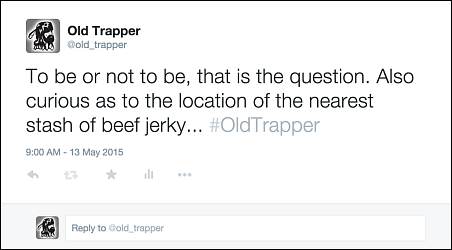
Click here to see the full version of this creative sample
The
day-to-day postings on social media are lighthearted and usually humorous, because "the stuff that's really funny and provocative and the stuff that naturally brings people to want to interact is the stuff that works best," he said.
Video content
Most of the videos are short, fun stories featuring The Old Trapper. The team also created series called
"Old Trapper Beefs," where the Old Trapper explores different pet peeves. The team has thought up around 300 ideas.
"Some of them will never see the light of day, because they're just not on point," he said. "We spend a lot of time thinking of beefs that are fairly universal and don't hurt anyone's feelings or don't really make fun of people," he said.
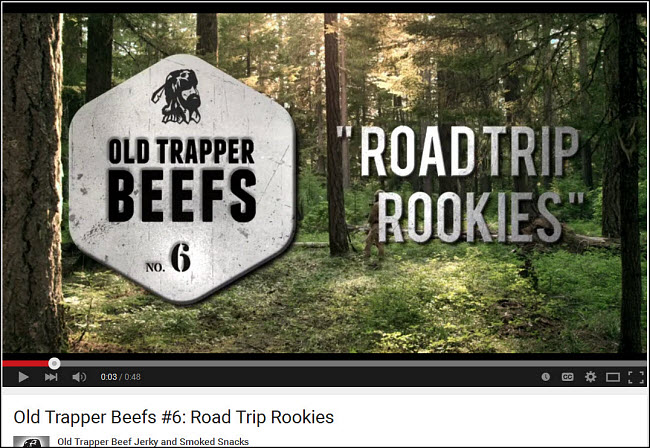
Click here to see the full version of this creative sample
Not all of the videos are the same across all social media channels, Leary said, because of timing issues. For instance, Instagram only allows 15 seconds, so a video will be trimmed to fit that.
All in all, Leary estimates that the team makes a little more than 75 videos a year, and the videos have a high view rate, with people generally watching the entire video.
However, the team has found some areas that need adjusting through this process, and are optimizing new videos being produced.
"In the world of social media, we're finding that one-minute-long is too long … We started finding that 18 seconds was the magical number that we needed to get to the punch line faster," he said.
Blog content
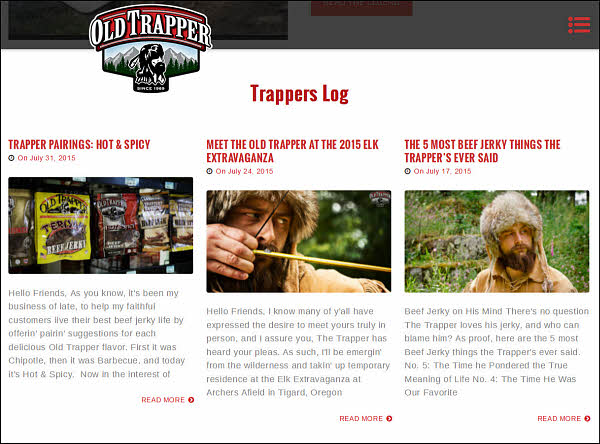
Click here to see the full version of this creative sample
The team also produces short blog posts on the website written from the point of view of The Old Trapper, called
"Trapper's Log." The team has two primary meetings every month; one is specifically for content.
"Our biggest challenge, day-to-day, is keeping the content ahead of schedule. And so we've got a pretty sophisticated content calendar to manage deadlines and assets that we need to acquire or old things we've already done that we can pull up and reuse and would keep the entire team centralized," Leary said.
The team has one primary content copywriter, but everyone comes together for that meeting every month to keep the calendar updated and brainstorm ideas. This is essential to making sure everyone is on the same page and all the necessary assets are in place, Leary said.
"I work on the written content and the storylines and the ideas and the outlines with our primary content writer, and then we go from there. It's just another way to tell the story of Old Trapper by not directly selling jerky but just letting The Old Trapper be a guy that you'd like to know," he said.
Step #3. Insert seasonality into content calendar
The team posts across social media networks and the blog almost every day or every other day, Leary said.
What keeps content fresh and exciting is integrating events and pop culture into the posts. For instance, The Old Trapper has live-tweeted the Oscars and the Super Bowl.
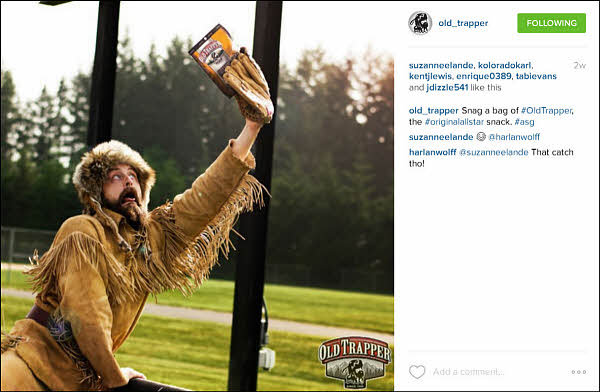
Click here to see the full version of this creative sample
For the MLB All-Star game, the team integrated in
pictures of The Old Trapper playing baseball — with a jerky theme, of course.
It's important to maintain this seasonality to bring in different aspects of The Old Trapper's personality. The team does this outside big sporting and entertainment events as well.
There are, of course, Trapper-specific holidays, such as national Log Cabin Day, where the team built a small log cabin out of jerky and posted a picture of it.
"We'll also do other normal national holidays," Leary said.
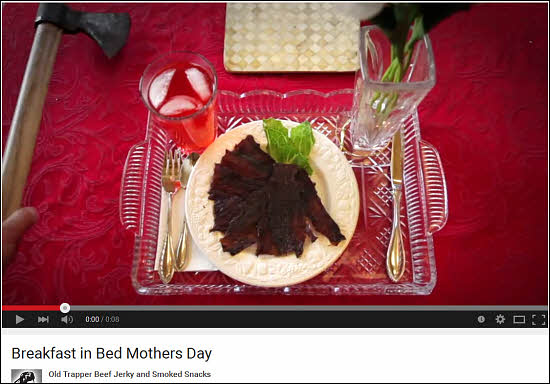
Click here to see the full version of this creative sample
"There are holidays where people just may buy stuff, like
Mother's Day, you know, 'Bring her the breakfast in bed she really wants,' and it was this whole set-up where Trapper's doing chores for her on Mother's Day, or Father's Day, you know, 'Give him the tie he wants' and he made a jerky tie," Leary said.
RESULTS
The new brand voice and social media presence provide the Old Trapper brand with a way to demonstrate its knowledge and ability to customers. It also allows the team to build confidence with the stores, buyers and distributors that are making the purchasing decisions.
"[It shows] that we're growing our likes, that we're growing our audiences on our own, shows the retail partners and the distributors that we're putting some marketing muscle behind the opportunity for them to sell our product," he said.
From May 2014 to May 2015, Old Trapper achieved the following results from this content and social media effort:
- A 2,113% increase in earned social media fans
- A 1,400% increase in social media engagement
"[Social media] touches everything, and we can measure it better than we can measure just about anything else besides our own internal sales data. It's just that everybody interacts with social in some way — whether it's Baby Boomers or Millennials — everybody does. They're all there. So we need to be there," he said.
The team will definitely continue what they have been doing, Leary said, because they are learning so much about their audience.
"We are looking at more live events — more events where people can come and meet The Old Trapper. Whenever we have him at a retail partner store, grand opening or anniversary event … that always gets a lot of social engagement. People love to come and visit The Trapper and get a selfie with him," Leary said.
Creative Samples
- Old Trapper tweet
- Old Trapper Beefs
- Trappers Log
- All-Star game post
- Mother's Day post
Sources
Old TrapperAnvil Media — Old Trapper's vendor
Related Resources
MarketingSherpa Summit 2016 — At the Bellagio in Las Vegas, February 22-24
Content Marketing 101: Tips on content strategy [From the MarketingSherpa blog]
B2B Content Marketing: 60% lift in site traffic from embracing an inbound strategyContent Marketing: How an energy data company's content strategy increased leads by 733%














